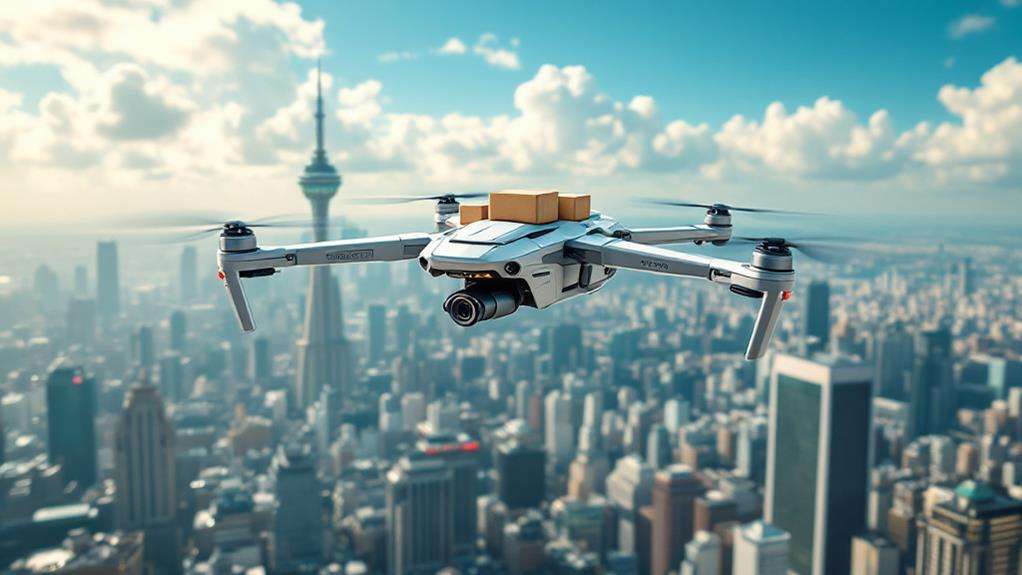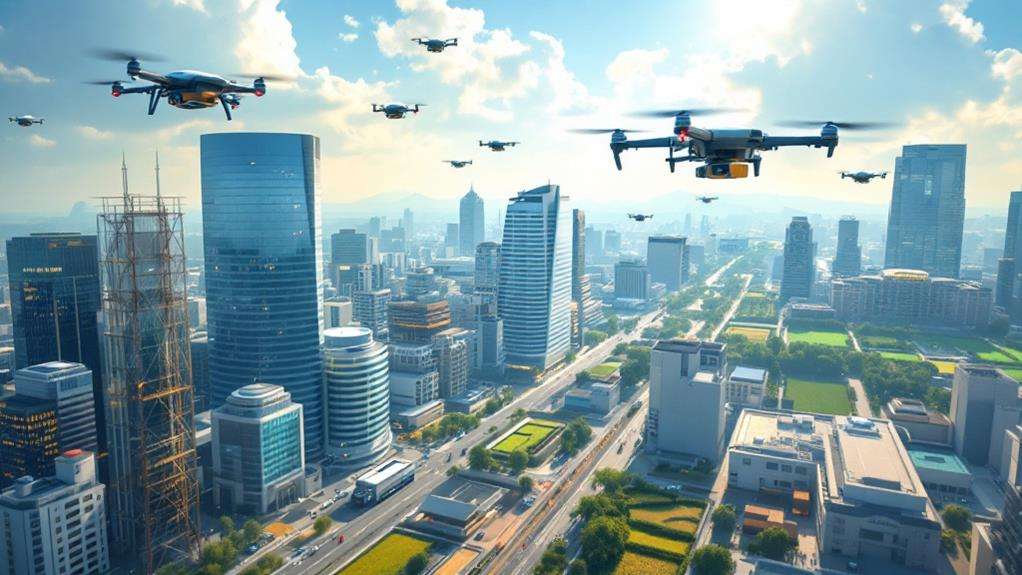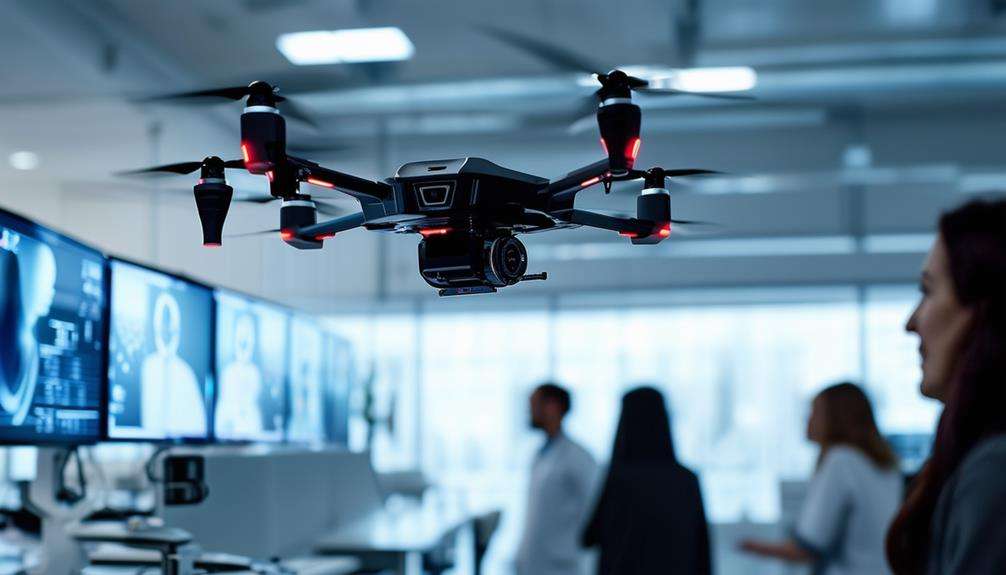How Much Can a Delivery Drone Carry?

A delivery drone's carrying capacity varies widely, depending on its type and design. Most commercial drones can carry between 2 kg and 30 kg. Lightweight models easily handle packages from 1 kg to 5 kg, while heavy lifters like the DJI FlyCart 30 can manage up to 30 kg. For extraordinary tasks, specialized drones such as the GRIFF Aviation 300 boast capabilities of up to 225 kg. Factors such as drone design, battery life, and regulatory limits also play crucial roles. There's plenty more to explore about the fascinating world of drone payload capacities and their impact on logistics.
Key Takeaways
- Commercial drones typically carry payloads ranging from 2 kg to 30 kg.
- Heavy lift drones like GRIFF Aviation 300 can support payloads up to 227 kg.
- DJI FlyCart 30 is capable of carrying up to 30 kg efficiently.
- Ehang 184 can transport payloads up to 100 kg with a flight time of 23 minutes.
- Payload capacities depend on drone design, battery life, and regulatory restrictions.
Types of Delivery Drones
When exploring the world of delivery drones, you'll find they come in several distinct types, each tailored for specific tasks. Multi-rotor drones are popular for their stability and ease of use, making them ideal for short-distance deliveries. Their payload capacity typically suits lighter goods, but models like the DJI FlyCart 30 can carry larger packages, handling up to 30 kg (66 lbs). These drones also integrate advanced obstacle avoidance systems, ensuring safe navigation in complex urban environments. In contrast, fixed-wing drones are more efficient for longer distances, offering greater range and speed. However, they might not match the same payload capacity as multi-rotor drones for heavier items. For those seeking a balance, hybrid delivery drones combine both electric and gas power, enhancing their endurance and range. These drones can carry payloads up to 20 pounds (approximately 9 kg), making them versatile for varying delivery needs.
If you're eyeing substantial payloads, the Ehang 184 stands out. While initially designed for personal transport, its maximum payload capacity of 100 kg (220 lbs) demonstrates its potential for fulfilling larger delivery needs. Generally, delivery drones cover a payload capacity spectrum from 5 kg to 220 kg, ensuring there's a type to meet diverse requirements.
Factors Affecting Weight Capacity
Understanding the factors that affect a delivery drone's weight capacity is crucial for optimizing its performance. The design of the drone plays a vital role, with heavy lift drones boasting payload capacities from 10 kg to 220 kg. These drones rely on strong power output, efficient motors, and large propellers to enhance their lifting capability. It's important to know that a drone's total weight capacity includes both its own weight and the payload. This means you'll need to pay close attention to drone specifications to ensure you don't exceed the maximum take-off weight. Drones used for delivery services revolutionize logistics by enabling rapid delivery of goods, significantly reducing delivery times compared to traditional methods. Battery life and flight duration are also key considerations. When a drone carries heavier payloads, it often requires more energy, which can reduce flight time and limit the drone's operational range. This is why balancing payload and battery efficiency is essential for effective drone operation. Additionally, you must consider regulatory restrictions, as they often impose limits on payload capacities. These restrictions vary by region, and it's important to comply to operate legally. By understanding these factors, you can maximize the efficiency and effectiveness of delivery drones, ensuring they meet both performance and legal standards.
Typical Payload Capacities

Delivery drones come in various designs, each with its own typical payload capacity. If you're exploring delivery services, understanding these capacities is crucial. Most commercial drones have payload capacities between 2 kg and 30 kg. For lightweight packages and everyday delivery needs, average commercial delivery drones are your best bet, efficiently handling goods weighing from 1 kg to 5 kg. These drones are perfect for small to medium-sized deliveries, leveraging advanced drone technology to provide swift and reliable service.
On the heavier side, some delivery drones are engineered for more robust applications. The DJI FlyCart 30, for example, can carry a maximum payload of 30 kg, making it suitable for heavier items. Then there are heavy payload drones, like the GRIFF Aviation 300, capable of supporting up to 225 kg. While this might be overkill for typical delivery services, it's ideal for heavy-duty applications where substantial weight capacity is needed.
In the realm of urban air mobility, models like the Ehang 184 are designed to transport up to 100 kg, bridging the gap between package delivery and passenger transport. Understanding these options helps you choose the right drone for your delivery needs.
High Payload Delivery Drones
Exploring the capabilities of delivery drones reveals a fascinating spectrum, especially as you move toward high payload models. These drones, often referred to as heavy lift drones, are designed to transport payloads that were once unimaginable for aerial vehicles. For instance, the DJI FlyCart 30 can carry a payload weight of up to 30 kg (66 lbs), whereas the GRIFF Aviation 300 boasts a lifting capacity of 227 kg (500 lbs). Such drones not only have impressive payload weights but also vary in maximum flight time and delivery range, impacting their overall efficiency.
| Drone Model | Payload Weight | Maximum Flight Time |
|---|---|---|
| DJI FlyCart 30 | 30 kg (66 lbs) | Not specified |
| GRIFF Aviation 300 | 227 kg (500 lbs) | Not specified |
| Ehang 184 | 100 kg (220 lbs) | 23 minutes |
| Ehang EH216-S | 220 kg (485 lbs) | Not specified |
| Draganfly Heavy Lift | 30 kg (66 lbs) | Not specified |
These high payload delivery drones are engineered for specific tasks, with some tailored for urban air mobility. They come at a cost, often exceeding $48,000, reflecting advanced technology. When choosing a drone, consider your specific needs to match lifting capacity and delivery range with your applications.
Industry Applications

Many industries are rapidly embracing delivery drones to enhance efficiency and reduce costs. With payload capacities typically ranging from 5 kg to 30 kg, drones are perfect for transporting small packages and goods. These capabilities make drones ideal for last-mile delivery, where speed and precision are crucial. Companies like Amazon and Walmart are already using drones to transport groceries and medicines, improving the efficiency of their logistics networks.
In the medical field, drones are increasingly being used to deliver critical medical supplies to remote or urban areas, ensuring timely access to essential items. This application is particularly vital for delivering blood samples, vaccines, and emergency medications, where every second counts.
The versatility in payload capacity, demonstrated by models like the DJI FlyCart 30 and Ehang 184, is revolutionizing transport logistics by offering rapid delivery solutions. By reducing delivery times in urban environments, drones enhance consumer satisfaction and streamline operations.
Moreover, integrating drones into delivery systems significantly lowers the carbon footprint compared to traditional vehicles, promoting a more sustainable approach to logistics. As industries continue to innovate, the applications of delivery drones will only expand, transforming how goods are transported worldwide.
Safety and Regulations
While the potential of delivery drones across various industries is undeniable, ensuring their safe operation is paramount. To achieve this, adhering to the weight limitations set by the FAA is crucial, as these directly affect payload capacities and operational range. Most delivery drones are built to carry between 2 kg and 30 kg, depending on their specifications and intended use. If you overload a drone beyond its weight capacity, it can lead to operational failure, potentially causing damage and safety hazards during flight.
Compliance with safety regulations requires you to implement fail-safe systems and collision avoidance technologies. These systems are essential for minimizing risks during drone delivery operations, especially in populated areas. Regulations also often mandate that drones maintain a visible line of sight, which impacts flight paths and how payloads are managed.




